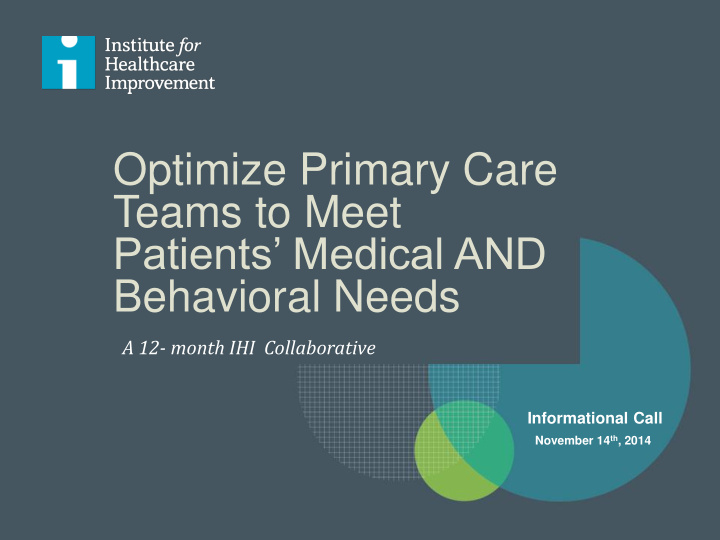



Optimize Primary Care Teams to Meet Patients’ Medical AND Behavioral Needs A 12- month IHI Collaborative Informational Call November 14 th , 2014
Goals of Today’s Call Describe the background, methods, and content to be used in the Optimize Primary Care Teams to Meet Patients’ Medical AND Behavioral Needs Collaborative. Describe the activities for the Collaborative. Answer your questions about the Collaborative.
Ways to share your questions and comments Raise your hand for your line to be Using the chat box: opened: Send your message to ‘All Participants’
Participant Introductions Please share with us: – Your name – Your organization – Where you are joining from
Collaborative Faculty Wendy Bradley, Connie Davis, Mara Laderman, Benjamin F. Miller, LPC, CCSAC MN, ARNP, RN MSPH PsyD Edward H. Wagner, Gerald Langley, Cindy Hupke, Kathleen Reims, MD, MPH, MACP MS BSN, MBA MD
6 Why do we need to work on this? • Poor outcomes and high costs for patients with medical + behavioral comorbidities. • Getting to the Triple Aim will require addressing behavioral health in primary care. • Changing incentives will facilitate this – the time is right to work on this now.
P7 Why focus on primary care teams? High performing primary care teams that include behavioral health capacity can effectively meet patients’ multiple medical and behavioral needs. Evidence shows that team-based primary care can improve quality and move towards the Triple Aim: Better health and functioning of individuals with chronic disease Better patient and provider satisfaction Lower per capita costs
P8 Answering Important Questions What are we trying to accomplish? How will we know that a change is an improvement? What changes can we make that might result in improvement? Langley, G.L.; Nolan, K.M.; Nolan, T.W.; Norman, C.L.; Provost, L.P. The Improvement Guide: A Practical Approach to Enhancing Organizational Performance
Collaborative Aim Participating organizations will redefine the composition and roles of primary care, building highly functional multidisciplinary teams that are fully equipped to address the physical and behavioral care needs of their population.
Within 12 Months participants will be able 10 to do the following within their pilot sites: Assess and segment the population served to understand medical and behavioral needs, identify barriers to better health, and target interventions to be tested. Optimize primary care team composition, roles, and activities to support integrated medical and behavioral health care (inclusive of mental health, substance abuse conditions, and healthy behaviors). Identify and implement an approach to integration that best meets the needs of the patient populations served, the primary care team, and the organization. Improve medical and behavioral health integration and care experience. Identify appropriate financial models, including quality contracts, global payment models, and grants to fund this transition. Develop a plan to scale up and sustain the model that has been developed and tested.
Definition of Integration 11 “The care that results from a practice team of primary care and behavioral health clinicians, working together with patients and families, using a systematic and cost-effective approach to provide patient-centered care for a defined population. This care may address mental health, substance abuse conditions, health behaviors (including their contribution to chronic medical illnesses), life stressors and crises, stress-related physical symptoms, and ineffective patterns of health care utilization.” AHRQ Integration Academy
12 Measurement Strategy Participants will collect and share data monthly to analyze and identify opportunities for improvement on measures relating to: Person Experience Screening and Follow-up Health Team functionality Health Costs
P13 What changes can I make…..?
Building a Medical Home Wagner EH et al. The changes involved in patient-centered medical home transformation. Prim Care. Jun 2012;39(2):241-259.
15 Lay the Foundation for Improvement Participants should have these elements in place and will continue to build and strengthen them throughout the Collaborative: Engage leadership Build quality improvement capability Empanel your patient population Adapted from the Safety Net Medical Home Initiative Framework http://www.safetynetmedicalhome.org/change-concepts
Design and Implement an 16 Integrated System of Care Develop Continuous and Team-based Healing Relationships Ensure Person- and Family-Centered Interactions Integrate Behavioral Health and Primary Care Services Develop an Effective System of Care Coordination Create a Sustainable Business Model Adapted from the Safety Net Medical Home Initiative Framework http://www.safetynetmedicalhome.org/change-concepts
17
Results Collaborative 12-month Collaborative 40-50 organizations 3 Learning Sessions, one will be face-to-face and will include a site visit Expectation: Engagement! Regular calls: All-team, measurement, leadership, and special interest calls Listserv Monthly reporting National Forum meeting – December, 2015 Harvesting and Evaluation – January, 2016 Use of QI methods- Model for Improvement and rapid, iterative learning shared among participants Shared measurement strategy Starts February 19, 2015
P19 Who Should Participate? Organizations committed to improving care in the primary care setting for individuals with both medical and behavioral health needs.
P20 Participants May Include: Health systems with primary care sites Hospitals with primary care sites (incorporated within or aligned with the hospital) Accountable care organizations (ACOs) Independent Physicians Associations/Organizations (IPAs/IPOs) Large group practices Integrated health systems Community health centers Primary care organizations that might be able to gain support from: Health plans, especially coordinated/managed care organizations Primary care associations States participating in federal demonstration projects Behavioral health services organizations Local community-based organizations Behavioral health organizations that want to integrate primary care
P21 Enrollment Fee The cost for one year of participation in the Collaborative is $20,000 per organization. A reduced rate of $10,000 per team applies to Federally- qualified health centers and safety net hospitals. A limited number of partial scholarships are available for safety-net organizations. One fee covers the calls, on-site participation in learning sessions for all team members (excluding travel expenses), and individualized coaching sessions from the expert faculty for 12 months.
P22 Questions and Discussion
February, 2015 Optimize Primary Care Teams to Meet Patients’ Medical AND Behavioral Needs: An IHI Collaborative Contact: primarycare@IHI.org
Recommend
More recommend